Laura Ford: Inside the Welsh sculptor's humorous and often terrifying work
The artist can achieve pathos, humour, absurdity and terror through a smart and surprising choice of medium
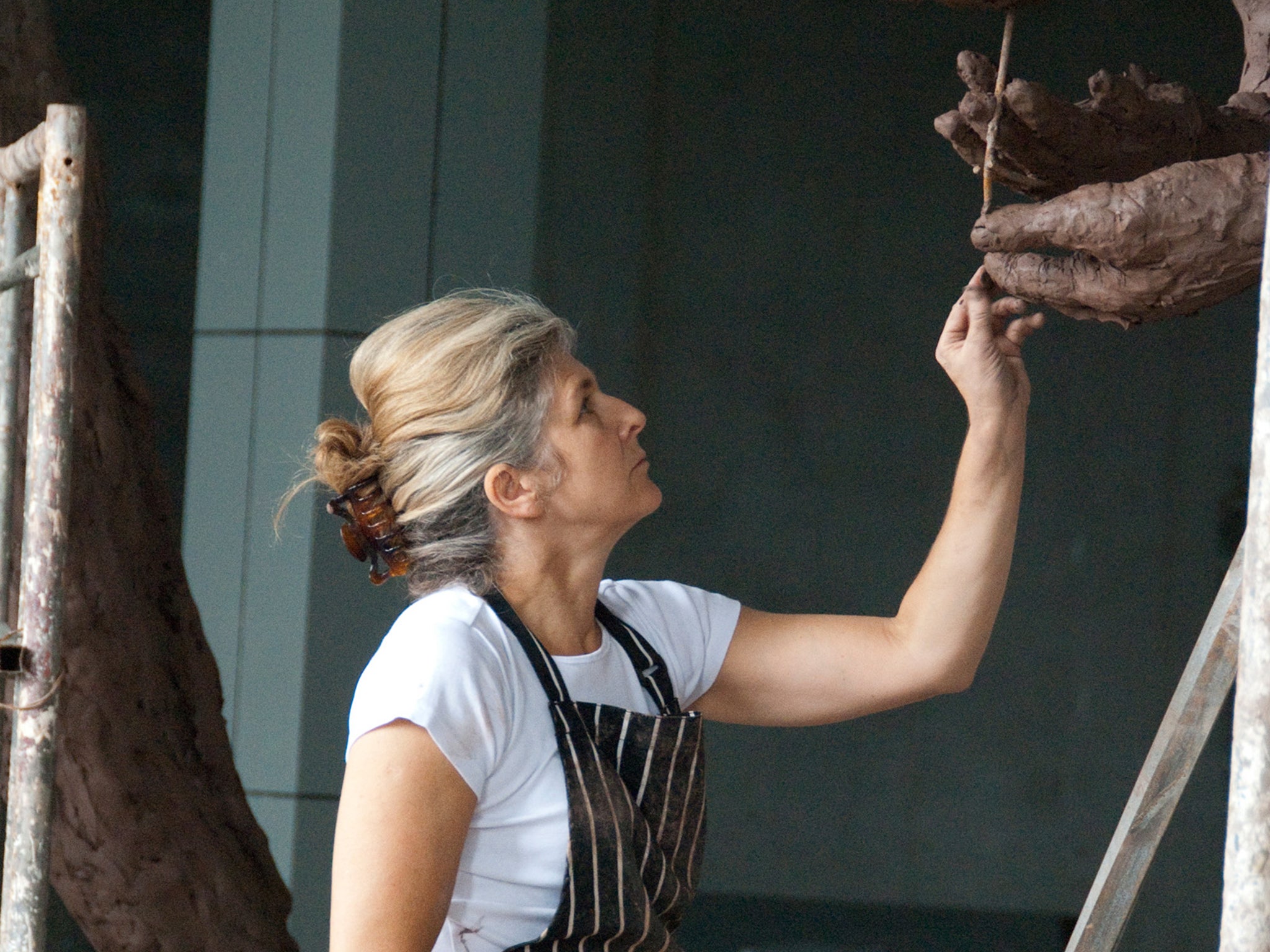
What sort of pain has made her turn her back on Windermere? One of Laura Ford’s Weeping Girl sculptures huddles on a wall in the garden of Blackwell. A curtain of hair conceals her face. Just beneath her, the long snake of the lake stretches beneath this Arts & Crafts mansion built in the late 1890s as a summer retreat for a Manchester brewing magnate. Beyond Windermere, snow still dusts the high fells of Coniston. No Lake District day-tripper could ask for a lovelier vista. Yet this girl – and another one, downcast beside a nearby tree – seems racked by a grief that no mere scenery can heal.
Made in a variety of materials, hard and soft, from bronze to fabric to ceramic, Ford’s figures often depict children or else animals with child-like traits. She has dubbed her works “sculptures dressed as people dressed as animals”. Forget preconceived ideas of whimsy or sentimentality. There’s comedy, certainly – but frequently with a sinister edge. And sometimes, as with those forlorn girls, her vein of anthropomorphic fable vanishes to reveal a raw anguish or dread. Later, I discover that Sir Edward Holt, the master brewer and mayor of Manchester who commissioned this house from architect Mackay Hugh Baillie Scott, would in 1915 lose his eldest son to the Battle of Gallipoli.
Both at Blackwell and at the Abbot Hall gallery in Kendal, Lakeland Arts have gathered a richly unsettling harvest of old and new works by Laura Ford. The twin focus show underscores her prowess as a conjuror of dark dreams out of metal, clay or cloth. The relocation of modern sculpture to charismatic venues can backfire. Star buildings or gardens may set up a background hum – an interference – that drowns out temporary guests. Not here. Ford has cunningly sited her pieces so that they talk with, and back to, their fresh settings.
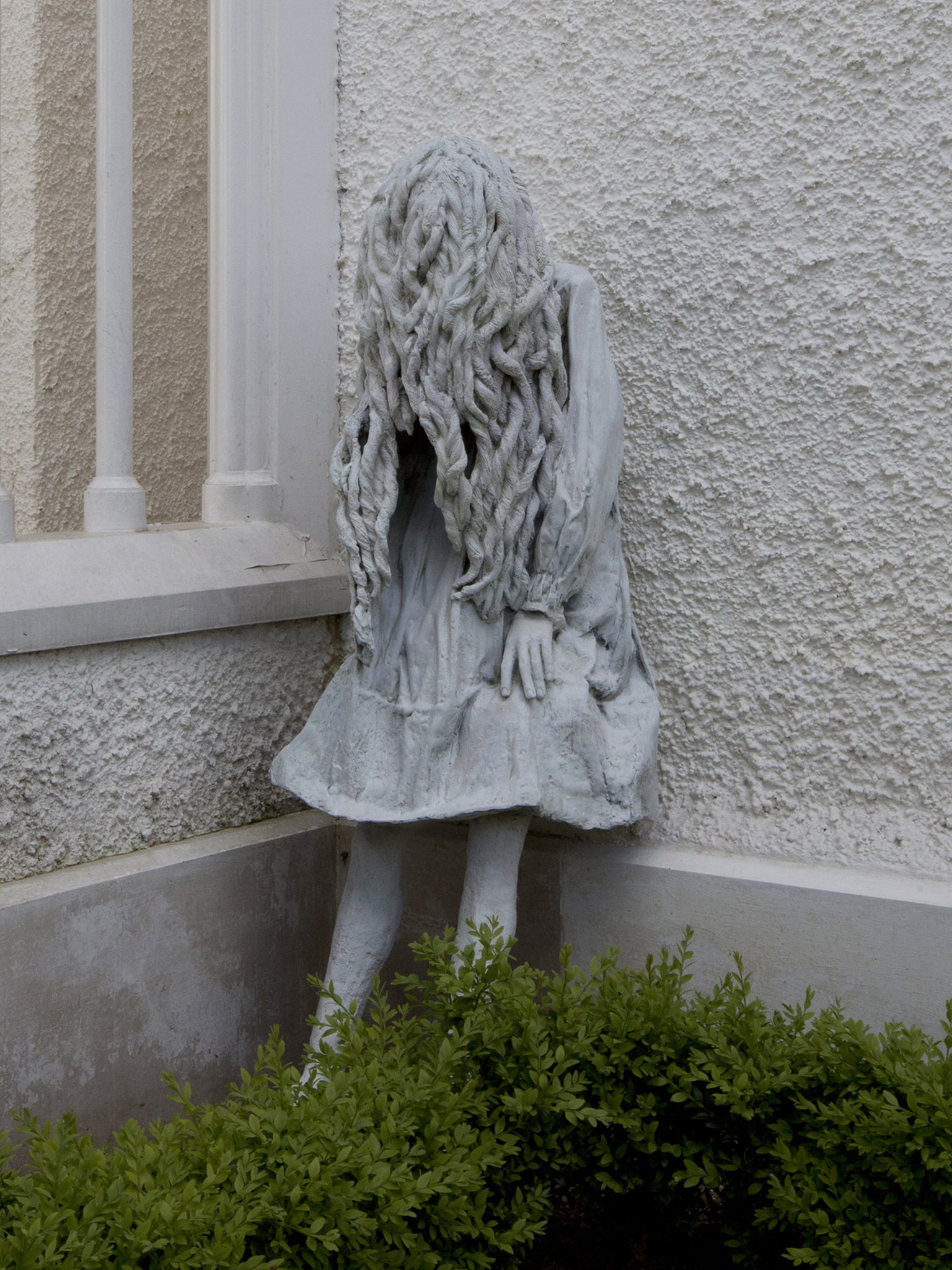
Take the saloon at Abbot Hall, which boasts a fine crop of 18th-century portraits by Kendal-boy-made-good George Romney. Ford’s Medieval Cloud Girls, a motley duo who might have strayed in from some early Netherlandish panel, gaze quizzically up at one of Romney’s signature pieces, the Gower Family. In that painting, four plump and sleek little aristos dance in a ring, while their older half-sister Lady Anne beats time. The quartet of kids came from Earl Gower’s third marriage; Anne, from his second. Ford’s mysterious pair of watchers seems to know something that they don’t. Et in Arcadia Ego: time, and its sidekick death, shadow even the grandest family and most sumptuous landscape.
Born in Cardiff in 1961, Laura Ford studied at Bath Academy, and specialised in sculpture at the Chelsea School. She hails from a fairground family: the sort of biographical factoid that critics adore. True, you may detect the mood of a grotesque sideshow in some groups of her freakish mixed-up beasties or little folk in grown-up garb. If so, this is a carnival of fear as well as fun. Above all, the vulnerability of children – or of animal figures who share a child-like jeopardy – runs across these pieces like a scarlet thread through a dark forest.
At Blackwell especially, her lost girls and boys – or their animal familiars – argue with the house in fruitful ways. Like his contemporaries Mackintosh and Voysey, Baillie Scott transformed traditional motifs from nature and history into a transitional style that bowed to the past but still greeted an airy, clean-lined, light-filled future. This historicist modernism tried to banish – or at least domesticate – its ghosts. Ford’s sculptures aren’t at all sure about that.
In the dining-room at Blackwell, her bear-like figure of Old Nick sits in a chair by the fireplace. This merry devil in bronze blows his outsize horn at the little maiden perched precariously on one shaggy knee. Up in the white drawing-room, meanwhile, with its breath-stopping panorama over Windermere, who’s that crestfallen creature on a shelf? This is Very Sorry Cat: a white ceramic feline clutching desperately at a blue bag like some under-age refugee.
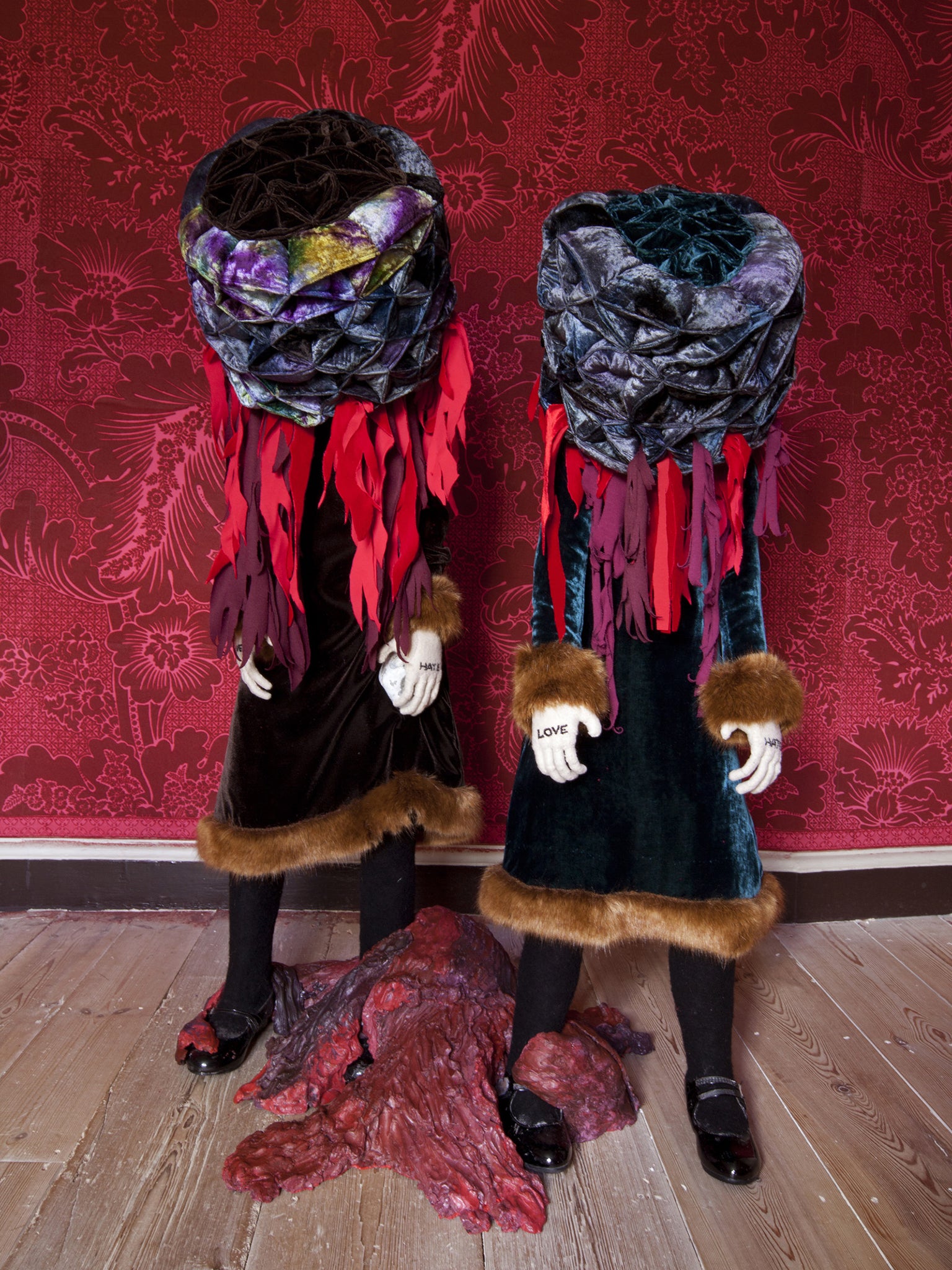
Fans of the art of Paula Rego, with its mythic and animalistic tableaux of gender and power, may well find a kindred spirit here. Ford herself has insisted that her pieces should not be read as specific narratives (“There is no story being told”) and rejected message-heavy agitprop: “I always found it impossible to make art about politics in a straightforward way”. Enthusiasts for post-Freudian mythologies will nonetheless find plenty to intrigue them – not to mention readers of Angela Carter’s neo-Gothic fairy-tales, or Marina Warner’s critical investigations into the demons and deities that haunt our cultural unconscious.
And yet... that sort of alignment makes Ford’s work sound willed, theorised, schematic. Not at all. To begin with, her bestiary sometimes has an almost cartoonish edge and punch. In the courtyard at Blackwell, just a hare’s leap away from the heart of the Beatrix Potter tourist industry, Ford has sited some skittish retakes (or takedowns) of Potterish-ish beasts. These animals have lost their storybook gentility and are now on the skids. Downwardly mobile, a Mrs Tiggywinkle-type hedgehog has become a bag-lady, complete with laden trolley. Clad in no doubt whiffy rags, badger rifles through a rubbish bin. A down-and-out fox begs outside the tea-room door. Austerity has traumatised the nursery. Beautifully fashioned, these pieces not only mock the sentimentality of the Potter cult. They restore dignity, even nobility, to the human counterparts of the derelict creatures they portray. Think of those soppy-cruel newspapers that alternate endless cute pics of animals with the snarling persecution of any fellow-humans who have failed in the Darwinian struggle for success.
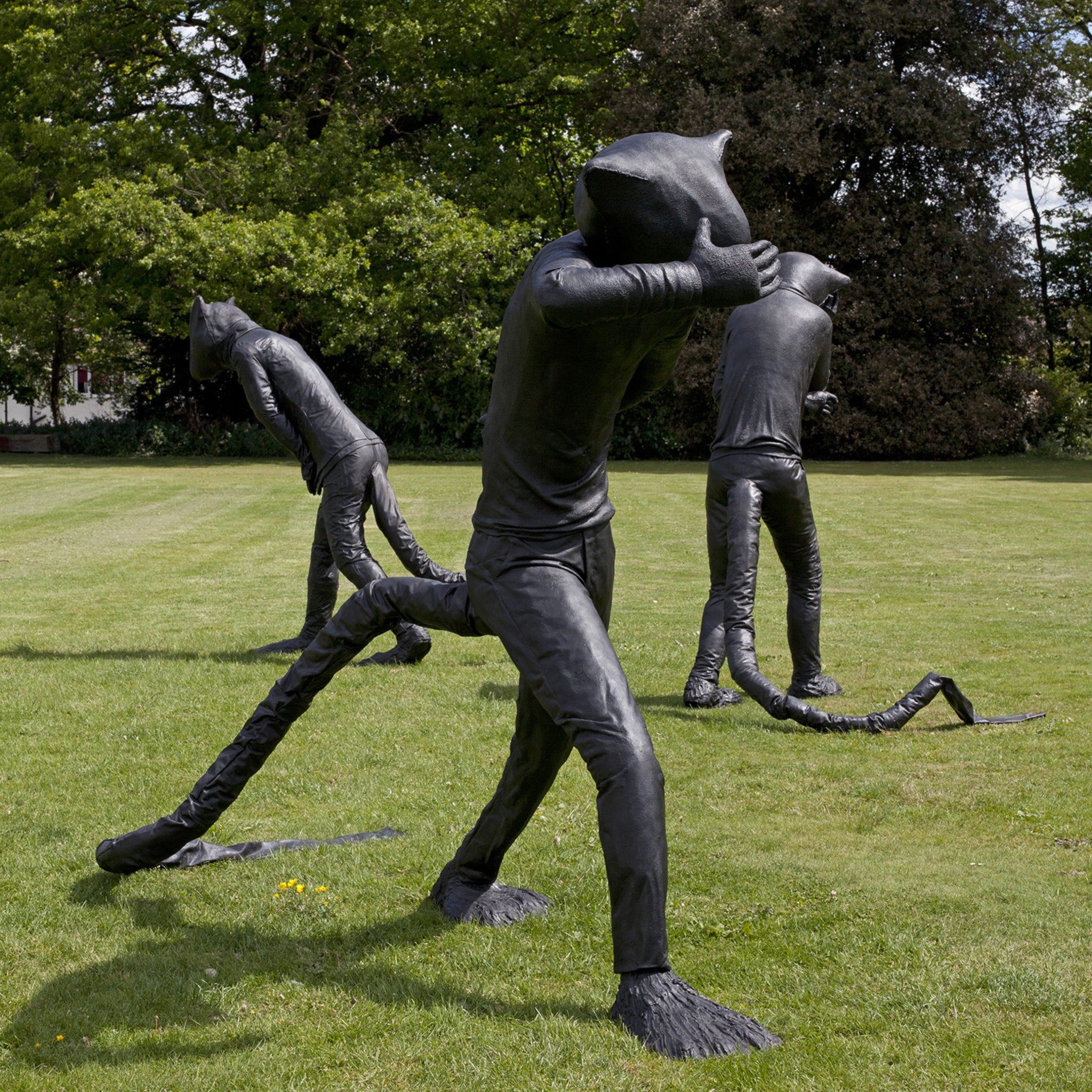
Over at Abbot Hall, some installations move Ford closer to a “nonsense” tradition of nursery-rhyme conundrums and brain-teasing juxtapositions. That room full of 13 child-sized soft penguins, stoutly shod but with floppy orange beaks: how does it make you feel? One stands a little apart from the gang. We can experience contemplative sadness, jolly solidarity – or both almost at once. Walk through this jigsaw of a piece, and its timbre changes with each step.
Sometimes, though, the impact can be overwhelming and immediate. In the pseudo-baronial central hall at Blackwell, five small armoured figures lie slumped on the floor or thrown against the wall. It looks like the scene of a massacre from some vicious war of yesteryear, or of today. Meet the Armour Boys. These downed bronze lads may refer, obliquely, to child soldiers in modern Africa, to the junior suits of armour Ford found in a Scottish castle, and to a mother’s sense of her children’s vulnerability at the time of the London bombings in 2005. Whatever: these tiny warriors crawl like medieval revenants through this picturesque fantasia of the pleasures of the distant past, without its risks and privations. By 1914, the family that spent happy summers here would know that the victimisation of youth was no longer ancient history.
Ford can achieve pathos, humour, absurdity and terror – all with a smart and often surprising choice of medium. The shape-shifting and metamorphic quality of her work has to do with the sheer stuff that forms it as much as the boundary-crossing creatures it portrays.
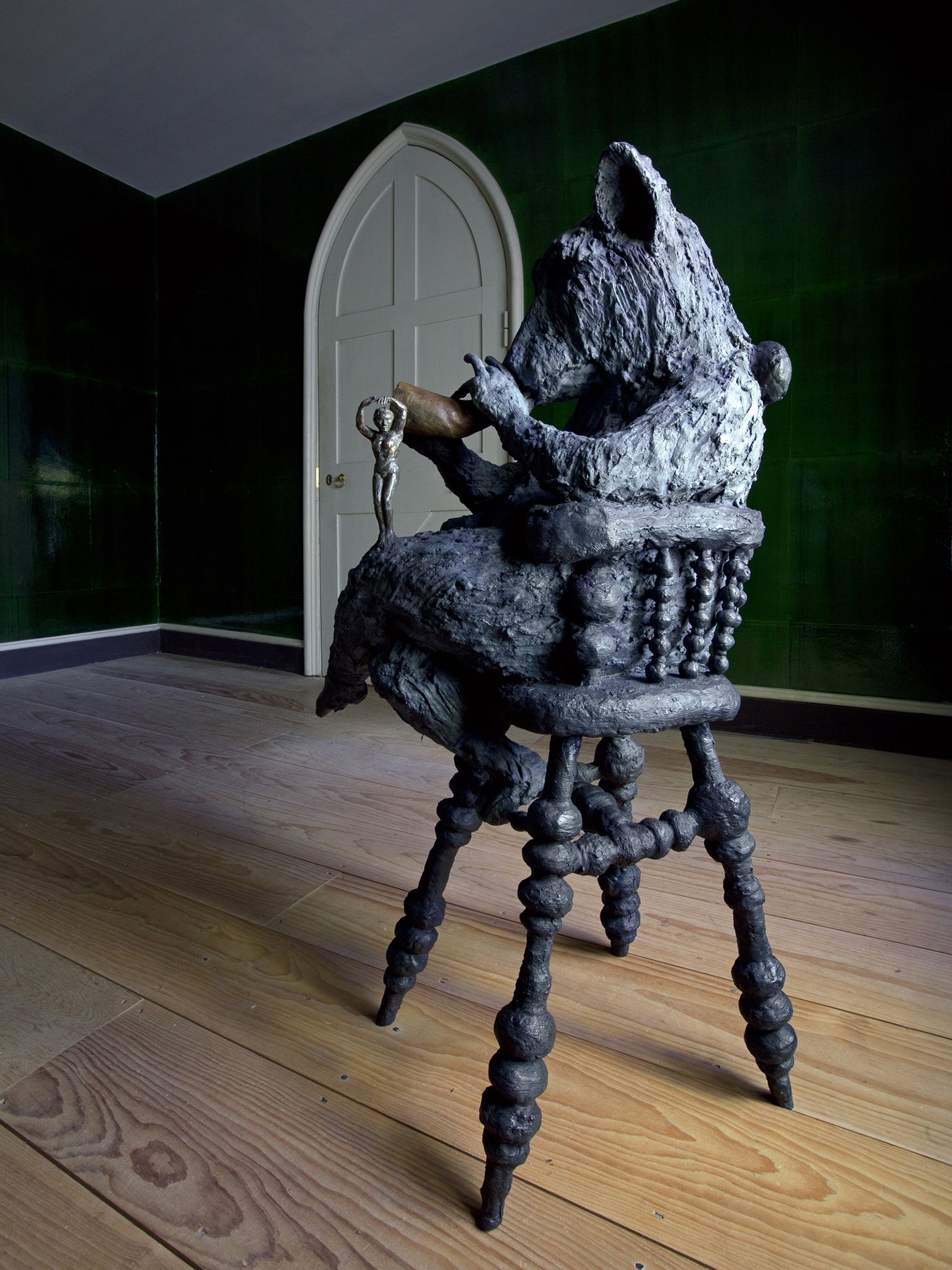
At Abbot Hall, a trio of periwigged poodles echo the pose of the Waldegrave sisters in a 1780 group portrait by Joshua Reynolds. So far, so clearly satirical: Georgian womenfolk reduced to clipped lapdogs. But these dogs stand proud as rather noble hounds, not fired in fragile porcelain but cast in hefty bronze. They have the solidity and grandeur that weight and texture confer. You would not kick, or cross, these poodles.
Back at Blackwell, one work dominates the entrance to the house. It may stalk the dreams of visitors for weeks – or years. Ford’s Days of Judgment is a posse of seven tall, humanoid cats. They stand on two legs while pacing a lawn that commands stunning views over Windermere. The sad cats ignore all that.
Aghast, forsaken, grief-stricken, their gestures and expressions nod to Masaccio’s 1420s fresco in a Florence church of the Expulsion of Adam and Eve from Eden. As with the Weeping Girls, the depth and stress of a nameless suffering cancels out the glory all around. Paradise is well and truly lost. In this landscape, how could I not remember Wordsworth? Childhood visions fade as adult woes blind injured eyes. As his “Ode: Intimations of Immortality”, written not far away, puts it: “Heaven lies about us in our infancy/ Shades of the prison-house begin to close/ Upon the growing boy”. And girl. The carnival may be over but, in Laura Ford’s figures, mirth as well as sorrow marks the end of innocence.
‘Laura Ford: Seen and Unseen’, at Abbot Hall Art Gallery, Kendal, Cumbria until 25 June, and at Blackwell: the Arts & Crafts House, Bowness-on-Windermere, Cumbria, until 4 September (abbothall.org.uk; blackwell.org.uk)
Join our commenting forum
Join thought-provoking conversations, follow other Independent readers and see their replies
Comments